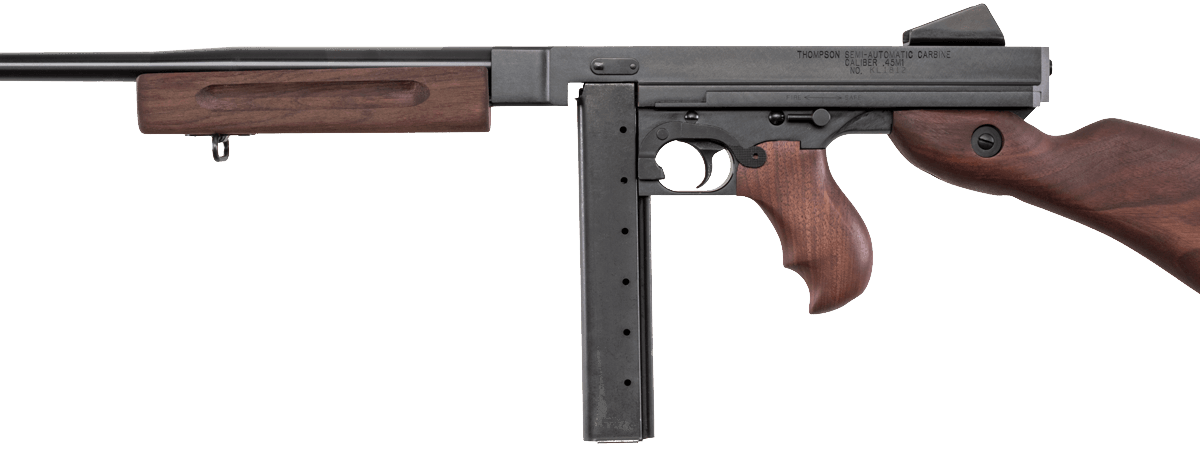How one brutally effective American icon bridged Prohibition and World War – and became one of the loudest symbols of American firepower.
Before Delta carried suppressed MP5’s, before Marines stacked bodies in Fallujah with M16’s, there was a time when American warfighters waded into battle with 10 pounds of walnut and steel. Slinging .45 caliber slugs at 700 rounds per minute, the Thompson submachine gun, better known as the Tommy Gun, was a cultural juggernaut and a battlefield wrecking ball. A product of American ingenuity, it carved its name into both the criminal underworld, and the chronicles of war.
Forged for Trenches That No Longer Needed Clearing
The story of the Thompson starts at the tail end of the Great War. General John T. Thompson, a veteran of the Spanish-American War, and the U.S. Army’s former Chief of Ordnance (which incidentally is my next dream job), envisioned a “trench-broom.” A compact, fully automatic weapon that could sweep enemy lines in the hellscape of no-mans-land. He partnered with the Auto-Ordnance Company, and by 1921, the first commercial Thompson had been born.
However, World War I had ended. The trenches had gone quiet, and the military had moved on. What was left was a beast of a weapon with no war to fight…at least, not yet.
Bullets and Bootleggers: The Gangland Years
The early years of the Thompson beg the question, “What happens when you invent the most devastating close-quarters firearm of its time, but the military isn’t buying?” The answer? It hits the civilian market, and during the Prohibition era, the streets of Chicago and New York became the new trenches and battlegrounds.
The Tommy Gun became the darling of gangsters and bank robbers across the country. Its sheer firepower was unmatched. Drum mags holding 50 or 100 rounds? Yes, thank you. Whether it was Capone’s enforcers, or Bonnie and Clyde on the run, the Thompson turned the American crime wave into something that felt like a war zone.
Law enforcement took notice, and eventually so did the public. G-men began using Thompsons in their own raids. FBI agents and Prohibition officers learned to love the same features that criminals exploited: overwhelming firepower in tight spaces. The Thompson became a fixture in headlines, movies, and public consciousness. It was both feared and admired.

The War Comes Calling
As World War II loomed, Uncle Sam finally came knocking. The Great Depression had slowed arms development, but the threat of global conflict brought urgency. By 1938, the U.S. Military formally adopted the Thompson. Variants like the M1928A1 were fielded first, followed by simplified wartime versions which stripped off the frills and drum mags in favor of stick mags and ease of manufacture.
American troops took the Tommy Gun to every front. Marines wielded them in the dense jungles of Guadalcanal and Tarawa. Paratroopers jumped into Normandy with them slung across their chests. From the hedgerows of France to the island-hopping campaigns of the Pacific, the Thompson was there, thunderous, reliable, and brutally effective in close quarters.
Troops often griped about its weight; fully loaded, it could hit nearly 12 pounds. When you were clearing bunkers or trenches however, the raw stopping power of .45 in full-auto erased a lot of those complaints. One or two bursts could end a fight before it began.

Design With Swagger
The Thompson wasn’t a soulless tool. It had character. With its polished walnut furniture, cooling fins on the barrel, and the iconic vertical foregrip (on early models), it looked more like something from a gangster film than a military arsenal. In fact, when I was a child, I didn’t believe it was a real firearm, purely a design of a film artist that stuck, but the Thompson wasn’t style over substance.
Its rate of fire, between 600 to 725 rounds per minute, was high enough to overwhelm, but not so fast it wasted ammo. It used the same .45 ACP round as the M1911, meaning logistics were simpler. It was also famously reliable under pressure. M1A1 variants even replaced the complicated Blish lock mechanism with a simple blowback system, keeping things rugged and combat-ready.
Still, the Thompson’s craftsmanship came at a cost. Milled from solid steel and built with quality wood, it was expensive to produce. That’s one reason why the U.S. eventually phased it out in favor of cheaper, stamped designs like the M3 “Grease Gun.” But by then, its legacy was already bulletproof.

Legacy Sealed in Steel and Smoke
Even after World War II, the Thompson kept fighting. It saw action in Korea and even popped up in early Vietnam. But by the late 1960s, it had become more of a symbol than a standard-issue weapon. Technology waits for no man, especially so for the ever-advancing tech gods of the military industrial complex.
Today, the Thompson is a collector’s dream, a mainstay in WWII films, video games, books, and a museum centerpiece. You’ll find it on re-enactors’ shoulders, in glass cases at military bases, and occasionally in the hands of ceremonial units honoring our past. The Tommy Gun isn’t just a firearm. It’s an American legend made of lead, wood, and brass.
Final Shots: American Muscle in Your Hands
The Thompson never asked for subtlety. It didn’t whisper across the battlefield or purr like a suppressed PDW. IT bellowed, it kicked, and delivered unmistakable power in the dirtiest, bloodiest corners of war and crime. Whether held by a Marine punching through a pillbox, or a Prohibition agent kicking down a bootlegger’s door, the Tommy Gun spoke one language fluidly: violence.
It’s history, of course, but it’s also heritage.
The Thompson is American firepower at its most unapologetic.
Read the full article here


